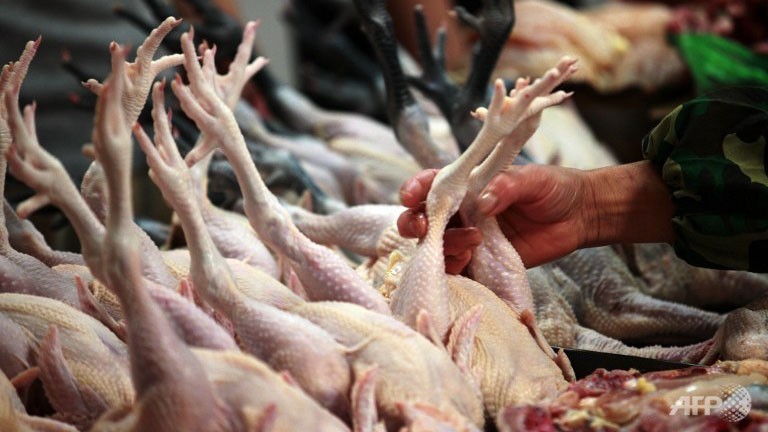H7N9 bird flu: Lancet study confirms poultry as source

File photo: People buy chicken at a market in China. (AFP PHOTO)
PARIS: Chinese researchers reporting in The Lancet on Thursday confirmed poultry as a source of H7N9 flu among humans but said they found no evidence of person-to-person transmission.
A probe into four cases of human H7N9 influenza in China's eastern Zhejiang province determined that all the patients had been exposed to poultry, either through their occupation or through visiting so-called wet poultry markets.
The World Health Organization (WHO) had previously said poultry were the likely source of the virus, which has been linked to at least 22 deaths out of 108 identified cases.
A team led by Lanjuan Li of Zhejiang University in Hangzhou and Kwok-Yung Yuen of the University of Hong Kong took rectal swaps from 20 chickens, four quails, five pigeons and 57 ducks all from six live poultry markets likely to have been visited by the patients.
Two of the pigeons and four of the chickens tested positive for H7N9 but the virus was not found in any of the ducks or quails.
The researchers analysed the genetic makeup of H7N9 found in one of the patients and compared it to a sample found in one of the infected chickens.
The similarities "suggest that it is being transmitted sporadically from poultry to humans," The Lancet said.
"This is the first time that definite bird-to-human transmission has been shown for the H7N9 virus."
Doctors also monitored 303 other people who were relatives or co-workers of the patients, as well as 82 healthcare workers.
"Nobody else who came into contact with the H7N9-infected patients began to show any symptoms within 14 days from the beginning of surveillance, suggesting that the virus is not currently able to transmit between human beings," the journal said.
However, further adaptation of the virus could lead to infections with less severe symptoms and "more efficient person-to-person transmission," the researchers cautioned.
What the stars mean:
★ Poor ★ ★ Promising ★★★ Good ★★★★ Very good ★★★★★ Exceptional
Latest News
More News
- Protect what’s next: towards a future free from meningococcal group B disease (December 05, 2025 | 18:00)
- New ILO report offers policy recommendations for disability inclusion (December 04, 2025 | 15:18)
- Maternal job loss may affect children’s mental health, research shows (December 03, 2025 | 19:11)
- Women lead Vietnam’s shift to climate-resilient agriculture (December 03, 2025 | 19:10)
- Experts highlight unpaid care work as key barrier to gender equality (December 03, 2025 | 15:15)
- Opportunities and inequalities for women workers in Vietnam's garment industry (December 03, 2025 | 09:00)
- Vietjet flights carry love to devastated central region (November 28, 2025 | 11:35)
- New initiative to boost the fight against domestic violence (November 26, 2025 | 10:00)
- South Korea funds IOM relief for Vietnam’s typhoon-affected communities (November 24, 2025 | 15:33)
- AI and human-centred values set to shape the future of HR in Vietnam (November 21, 2025 | 18:04)

















 Mobile Version
Mobile Version